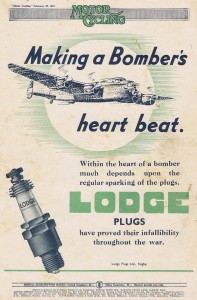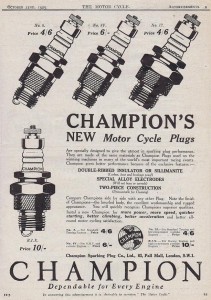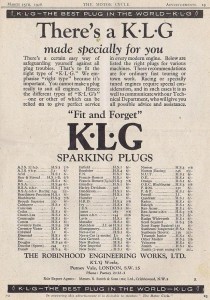As a younger person I didn’t really put much stock in the correct type of spark plug for my motorcycles. Correct thread size was of course important but this projected tip, non projected tip, appropriate heat range nonsense was not worthy of my time and any decision 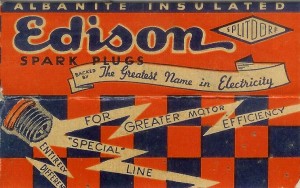 on what to use was based purely on cost the cheaper the better, and free was excellent. Naturally I had a few disasters and as a slow learner the only thing I understood was that if I put a 3/4 reach plug in place of the 1/2 reach plug into my 70cc BSA Dandy 2 stroke that it would make the combustion space smaller thus upping the compression, make the ‘bang’ better and I would of course go faster. Or so the world would have had me believe. But in reality the bike was hard to start, didn’t run very well and the excess thread protruding into the cylinder carboned up and made plug removal difficult. Upon reflection I think that the root cause of my spark plug ignorance goes back even further to the youngster days of a very young McSnipper and the guiding light of Grampy McSnotty, a man who I had the utmost respect for and who was instrumental in the early days of my mechanical training.
on what to use was based purely on cost the cheaper the better, and free was excellent. Naturally I had a few disasters and as a slow learner the only thing I understood was that if I put a 3/4 reach plug in place of the 1/2 reach plug into my 70cc BSA Dandy 2 stroke that it would make the combustion space smaller thus upping the compression, make the ‘bang’ better and I would of course go faster. Or so the world would have had me believe. But in reality the bike was hard to start, didn’t run very well and the excess thread protruding into the cylinder carboned up and made plug removal difficult. Upon reflection I think that the root cause of my spark plug ignorance goes back even further to the youngster days of a very young McSnipper and the guiding light of Grampy McSnotty, a man who I had the utmost respect for and who was instrumental in the early days of my mechanical training.
Grampy McS was a man who had survived bankruptcy of the 1920s and the depression of the 1930s so everything to him had a value and a use, whether it be brand new, sort of new, secondhand, extremely secondhand, could be useful, and absolutely no use at all (but was still kept). Nothing was thrown away. It was this philosophy that I was to inherit and it would take years to dispose myself of some of the lesser favourable lessons taught (the most favourite still witnessed in use today by others using a hammer and cold chisel to undo a nut!).
And so we enter the story of Grampys Magic Box of Spark Plugs.
Spending the school holidays with Grampy McS was something that I always looked forward to. It was just him and me. We would work around the house, break things, pull things apart (which seldom went back together again), cook bachelor meals and go driving in a 1939 Chev. It would be this vehicle that I learnt a lot from as miles clocked up necessitated the need of basic maintenance to be performed and the first item would be plugs. This was usually after a misfire was detected whilst in transit somewhere and would result in a comment from Grampy of best we fix that when we get home. We could afford to wait until we got home because it was always a ‘minor miss’ of which I could never hear however to the experienced ear of Grampy it was there. And if the trouble did worsen and a roadside repair was required then there was a complete toolkit on the back floor (yes old cars had floors, not small restrictive foot wells of the modern automobile).
Part of this next lesson to be taught was the art of fault finding. It was alright for Grampy McS to exercise his many years of experience and say that the motor had a miss but to locate the fault and fix it was another chapter. Without the aid of modern spark analysers and high voltage testers the simple use of an old screwdriver bridging the exposed spark plug cap to earth would give the same result a misfiring cylinder. A simple fix no doubt for most modern day technicians’, a quick visit to SuperCheap, impart with some money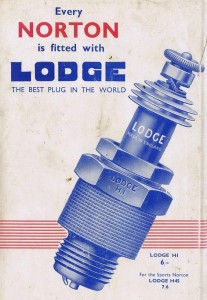 and walk out with a brand new set x6 of spark plugs (as we all know if one is faulty then the other 5 won’t be far behind right??). Well not in Grampys case, in all my years as his faithful follower I was never witness to him buying even one new spark plug let alone six! Instead I would venture up to the workshop with my trolley and return with an old wooden nailbox brimming with used spark plugs yes it was Grampys Box of Magic Spark Plugs. This box housed any and every type of spark plug probably ever made, well it seemed that way. There were round ones, hexagon ones, blue ones, green ones, and pink ones. Champion, Splitdorf, Lodge, and Edison. If it had been made then it was more than likely in the box. This collection was from years of breaking engines and keeping the parts. I only wish that I had that box now. What a treasure trove it would be.
and walk out with a brand new set x6 of spark plugs (as we all know if one is faulty then the other 5 won’t be far behind right??). Well not in Grampys case, in all my years as his faithful follower I was never witness to him buying even one new spark plug let alone six! Instead I would venture up to the workshop with my trolley and return with an old wooden nailbox brimming with used spark plugs yes it was Grampys Box of Magic Spark Plugs. This box housed any and every type of spark plug probably ever made, well it seemed that way. There were round ones, hexagon ones, blue ones, green ones, and pink ones. Champion, Splitdorf, Lodge, and Edison. If it had been made then it was more than likely in the box. This collection was from years of breaking engines and keeping the parts. I only wish that I had that box now. What a treasure trove it would be.
By the time I had returned the offending plug would have been removed and placed on the outdoor workbench, in this case the running board of the Chev. Sorting through the box for any similar type of plug would result in a small queue again on the running board waiting for the inspection of Grampy. He would pick up each one individually, give it a blow, a quick wipe on a rag (or his shirt) and with his trained eye would hold each one up to the light for inspection. In order of priority they would be placed back on the running board to be wire brushed clean, plug gap reset and then tried in the engine for suitability. Success would be achieved, the engine would start and run as well as ever and the remaining plugs would be returned to the magic box. And the offending plug that was removed well it was returned to the box as well to be used again in later times of course. Like everything else nothing thrown away, everything saved.
But times have changed since then, engines have become more reliable, fuels burn cleaner and spark plugs are cheap enough that they can be replaced easily at minimal cost. The days of having to dismantle a plug to clean it, reassemble it and hopefully it won’t leak are long gone (thank goodness).
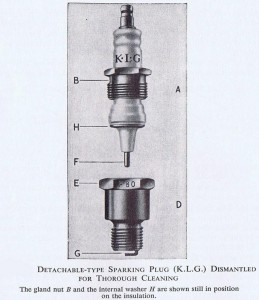
A Detachable Plug Dismantled For Cleaning.
Running an old motorcycle is an enjoyable hobby but when it comes to even the most basic of chores like spark plugs problems can arise. There is very little information available on early spark plugs and the different grades (or heat ranges), and as with all things making the wrong choice can have disasterous results. Premature burning of spark plug tips, and holed pistons are just some of the problems owners have to contend with should an incorrect plug be used.
To assist owners we have scoured our old 1920s and 30s manuals for the manufacturers recommended spark plug types, it is not complete however we hope that it has some value for some of the more common makes of machines. Click here to go to the chart.
Unlike new spark plugs which come in a cardboard box with a plastic sleeve older plugs when new came wrapped in a wax paper (to protect from moisture) with instructions and nicely presented in a tin box, some even had a sand paper card to assist in cleaning the sparking gap. Click here to see some of the older syle instruction sheets.
One of the most useful spark plug charts is the 1960s Champion Heat Range Comparison Chart. It includes all the sizes and heat ranges from 10mm to 7/8 plugs and their equivalents with respect to AC, AUTOLITE, BOSCH, KLG and LODGE. Click here to see the chart.
Champion have superceeded many plug types over the years and have managed to keep track of what grade was changed to what. Click here to see the Supercession List.
I have included the NGK Plug Identification Chart which can help identify the coding of NGK spark plugs. Useful if you come across some plugs that look useful but have additional coding in the grading. Click here to see the chart.
What was good for Our Boys in WW2 would definitely be good for our motorcycles. See what else was good for your motorcycles in the 1920s and 30s by clicking on the advertisement (1M PDF).
1925 Champion Advertisement with Plug Grades.
1926 KLG Advertisement With Manufacturer Fitment.
Modern Use (in NZ).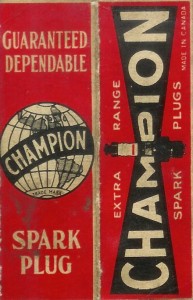
We have all become used to the difficulties in owning and riding older motorcycles, and obtaining parts to keep them on the road can be quite a challenge, spark plugs being no different. An upgrade well worth considering is the use of thread reducers to change from your 7/8 and 18mm spark plugs to 14mm. This gives the rider more heat ranges to choose from, and easy access to replacement 14mm spark plugs from service stations should he/she need extras to get home. The ‘Rivet Counters’ might cringe but the piece of mind from having new modern spark plugs is well worth the trade-off, especially if you use your older steed regularly.
Cost is also an issue with older plugs. NGK 18mm plugs are $15 each, and NOS (New Old Stock ie Firestone, Lodge, Splitdorf) 18mm and 7/8 plugs can be anywhere upwards from $20 each. Can be very expensive should you experience a fueling problem that causes the insulator to break down which means plugs cannot be reused reliably. Standard NGK 14mm plugs are $7.00 (some others are even cheaper).
Note if a plug becomes oiled up DO NOT wash it clean with petrol (I have seen riders doing this with a hot plug dangling off the end of a piece of wire into a petrol tank half full of gas only luck has saved them from being dispatched to the next world!) This will make the reliability of the plug questionable due to the saturation of the insulator with the additives in the fuel. Modern fuels are pretty hard on plugs and unlike the ‘old days’ where plugs could be dismantled, cleaned, reassembled and reused successfully today reliability can only be maintained by the total replacement of the old plug with a new one.
Fitment of inserts there are ready made inserts available from vintage suppliers for fitment however my past experiences have been that most are too short and not of a high quality. The tolerances that these are machined to are fairly general and as you are screwing them into already worn threads they never stay in, so when you remove the spark plug the insert remains attached to the plug. Ideally inserts should be machined individually to each thread requirement and locked in with a hi temperature sealer, I use an exhaust manifold sealer than cures with heat the next time the engine is started.
A few suppliers are having original style spark plugs made however the heat range is limited, they are very expensive and should one fail on the roadside and you don’t have a spare then the return journey for your machine will be in the back of a van.
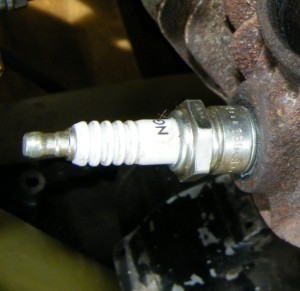
1926 Harley Davidson fitted with 7/8 to 14mm spark plug adapters.
This finally brings us to the question of what can we use in our machines today? Owners have their own personal preferences towards make with some having unquestionable loyalty to one particular brand. Knobsters preference is far more simple, he likes pink spark plugs (salmon to the SNAG Sensitive New Age Guy) and so uses Firestone or Lodge. I really wonder about that guy he even proudly showed me a photo of him wearing a dress!! Something about Scotland came into the conversation but I still don’t think that it should have been strapless and backless!
My preference is towards NGK plugs having gained confidence from them with over 30 plus years of use whereas others I ride with prefer Bosch. There doesn’t seem to be much support for the modern Champion plug for our older bikes, and yet they seem to perform quite well in modern cars. Perhaps it has something to do with modern fuel metering with injection systems whereas our machines rely on lesser stringent fuel control, old style carburettors with worn throttle slides, old jets, and constantly varying float levels.
We have endeavoured to put together a chart that cross references some of the older plugs used from the 1930s to the 1970s, and where they fit within the NGK range. It appears that there was a wide and varied range of plugs for the same application through this period and this has been shaped down to a few basic grades within the modern application. Supply is also an issue and can be very limiting, for example NGK have listed 2 grades for 18mm A6 and A8*, and the only one readily available is the A6 (a good reason to fit 14mm adapters).
| Champion | KLG | Lodge | NGK | |
| 18mm | D14, D16 | M50, M60 | C3-18, C1-18,CV, H1, HBV | A6 |
| D6 | M80 | H1P, HN18P, HV-18, 2HV | A8* | |
| 14mm (1/2 reach)** | L88A, L90 | F50, F70 | CN, HBN | B5HS |
| L7, L10, L85, L86 | F75 | C14, CC14, HN, H | B6HS | |
| L4J, L5, L81 | F80 | 2H, 2HN | B7HS | |
| L78 | F100 | 3HN | B8HS | |
| L62R, L60R, L57R, L77J | F220 | R47, R49, R50 | B9HS |
**Note very little (if any) 14mm 3/4 reach plugs were in use in the 1930s, with most being only 1/2 reach. Most spark plugs in the 1920s seem to have been 18mm.
These conversions were made up from various 1960s~90s spark plug guides, and cross referenced with the NGK handbook. If you are unsure as to the correctness of the above information for your machine consult with your local motorcycle shop. They can be very helpful.
|
Champion |
KLG |
Lodge |
NGK |
|
|
18mm |
D14, D16 |
M50, M60 |
C3-18, C1-18,CV, H1, HBV |
A6 |
|
D6 |
M80 |
H1P, HN18P, HV-18, 2HV |
A8* |
|
|
14mm (1/2 reach)** |
L88A, L90 |
F50, F70 |
CN, HBN |
B5HS |
|
L7, L10, L85, L86 |
F75 |
C14, CC14, HN, H |
B6HS |
|
|
L4J, L5, L81 |
F80 |
2H, 2HN |
B7HS |
|
|
L78 |
F100 |
3HN |
B8HS |
|
|
L62R, L60R, L57R, L77J |
F220 |
R47, R49, R50 |
B9HS |

